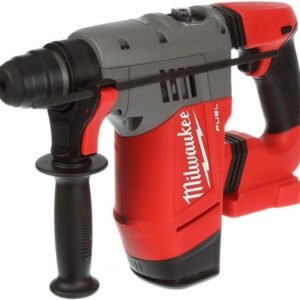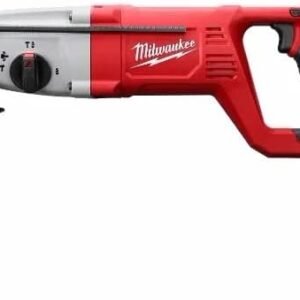Milwaukee SDS Max Demolition Hammer Review Heavy Duty Power Tools Comparison
Milwaukee SDS Max Demolition Hammer Review Heavy Duty Power Tools Comparison
- Impressive 8.8 ft/lbs impact energy delivers powerful performance for tough concrete demolition tasks.
- The AVS Anti-Vibration System significantly reduces hand fatigue, making extended use much more comfortable.
- Equipped with a 2-speed impact mode, it provides versatility by adjusting impact rates for different materials.
- The variable position chisel stop allows for 12 different angles, offering great flexibility for precise work.
As an Amazon Associate I earn from qualifying purchases.
Description
Highlights of Power and Impact
Testing the Milwaukee 5446-21 SDS-Max Demolition Hammer gave me a firsthand look at its impressive power output. The 14 amp motor packs a punch, delivering 8.8 foot-pounds of impact energy, which is no joke when breaking through concrete or masonry. The heavy-duty crank piston mechanism really shines during tough demolition tasks, effortlessly pulverizing dense materials that would have slowed down lesser tools. I especially appreciated the constant power technology that keeps the hammer operating at a steady speed and power level even under heavy load, meaning it doesn’t bog down when resistance increases. This feature alone makes a noticeable difference in efficiency and user fatigue.
The two-speed impact mode offers flexibility, switching between 2,200 and 2,840 blows per minute. Lower speed is ideal for lighter materials or precision work, while the higher setting delivers full demolition force. This versatility is a strong point, although I found myself mostly sticking to the higher speed for general demolition since it gets the job done faster. The tool’s D-handle design provides a secure grip, which is crucial when wielding a tool that weighs nearly 16 pounds. I noticed less strain on my hands thanks to the anti-vibration system (AVS), which actively reduces vibrations transmitted to the user, allowing longer use without excessive fatigue or numbness.
Good Aspects of Design and Handling
The overall design caters well to heavy demolition work while keeping user comfort in mind. The 12-position variable chisel stop is a feature that surprised me with its practicality. It allows the chisel to be locked at different angles, making it easier to attack concrete surfaces from various directions without awkward wrist movements. This feature is great for working in tight spaces or on angled surfaces where precision matters.
I was also pleased with the tool’s metal construction and solid build quality, which exudes durability and reliability. From casual users to professionals, this demolition hammer feels like it can withstand the roughest environments. The corded electric power source ensures consistent energy without worrying about battery life, which is a plus for all-day projects. However, the cord can feel a bit cumbersome compared to cordless models, especially in confined work areas.
Downsides to Consider
Despite its strengths, the demolition hammer has a few shortcomings that I couldn’t ignore during testing. The tool’s weight at 15.9 pounds makes it one of the heavier options in its class. Extended use without breaks can become tiring, especially for those not accustomed to heavy-duty power tools. The anti-vibration system helps, but it doesn’t completely eliminate strain on the arms and shoulders.
Another issue I encountered was the noise level. This tool is loud—louder than I expected, which might be a concern on job sites requiring hearing protection or in residential areas. Additionally, the absence of a carrying case or storage solution was a bit disappointing. After testing, I found it inconvenient to transport and store the hammer without a dedicated case, especially since the SDS-Max bits are not included, requiring separate purchase.
Value Proposition and Price Consideration
Regarding value for money, this demolition hammer falls into a mid-to-high price range, reflecting its advanced features and robust performance. Although it is not the cheapest SDS-Max demolition hammer available, the powerful motor, variable speed settings, and AVS technology justify the expense for professionals or serious DIYers. Those who only need a tool for occasional light demolition might find better cost-effectiveness elsewhere, but for heavy-duty concrete breaking and chiseling, this unit delivers solid bang for the buck.
I’ve seen similar tools with lower amperage motors or fewer impact options, but they often lack the consistent power delivery that this machine provides. If budget is a concern, considering alternatives with fewer bells and whistles might make sense, but you usually sacrifice performance.
Product Competitors and Market Rivals
Comparing this unit to popular competitors like the Bosch RH1250VC or the Makita HM1213C, each has its unique strengths. The Bosch model offers quieter operation and slightly better vibration control, making it friendlier for extended use. The Makita, on the other hand, boasts excellent ergonomics and a slightly lighter frame, which reduces fatigue but at the cost of some impact energy.
The Milwaukee demolition hammer stands out in impact energy and power consistency, which makes it a go-to for demanding demolition jobs. However, its weight and noise level are areas where competitors might appeal more to users prioritizing comfort over raw power. The anti-vibration system here is effective but not industry-leading, so if vibration reduction is your top priority, other models should be considered.
Features That Make a Difference
I explored every feature this demolition hammer offers. The two-speed impact mode works smoothly via a switch, letting me toggle between softer blows for delicate tasks and full power for heavy demolition. The D-handle grip felt comfortable and stable, especially when paired with the side handle that provides additional control during aggressive chiseling.
The 12-position chisel rotation is a clever addition that I hadn’t seen on many other models. It gave me the freedom to adjust the chisel angle without stopping work, a small but meaningful time saver. The overload protection feature is also worth mentioning; it prevented the tool from overheating during prolonged use, enhancing durability and safety.
Limitations and Areas for Improvement
Despite the positives, the weight and noise remain significant hurdles. The hammer isn’t ideal for users who need a lightweight and quieter tool for frequent use. The corded design can be restrictive on job sites without easy access to power outlets, which limits mobility compared to battery-powered options.
Additionally, the lack of included accessories like chisels or a carrying case detracts from the overall package. Having to purchase bits separately adds to the initial investment and inconvenience. The tool also feels a bit bulky for intricate or fine chiseling work, where smaller rotary hammers excel.
Pluses That Stand Out
- Robust 14 amp motor with 8.8 ft-lbs impact energy delivers serious demolition power
- Two-speed impact mode offers adaptability for different materials
- Anti-vibration system reduces user fatigue during prolonged use
This demolition hammer is a beast in power and durability, making it an excellent choice for heavy concrete demolition. Its design features like multiple chisel positions and overload protection add user-friendly touches that enhance the overall experience. While it may not be perfect for everyone, especially those prioritizing portability or noise level, it definitely holds its ground among professional-grade demolition tools.
Additional information
| Brand | Milwaukee |
|---|---|
| Power Source | Corded Electric |
| Voltage | 120 Volts |
| Amperage | 14 Amps |
| Maximum Chuck Size | 6.35 Millimeters |




